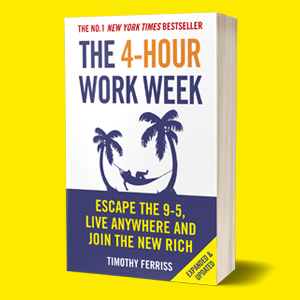
Escape the 9-5, Live Anywhere, and Join the New Rich
Tim Ferriss’s The 4 Hour Workweek is a revolutionary guide to living a more efficient and fulfilling life by challenging the traditional concepts of work and retirement. Published in 2007, this book has become a must-read for entrepreneurs, freelancers, and anyone looking to escape the conventional 9-5 grind. Ferriss introduces the concept of the “New Rich” (NR), individuals who design their lifestyles around maximum efficiency and freedom rather than accumulating wealth to enjoy later in life. The book is divided into four sections, following the acronym D.E.A.L., which stands for Definition, Elimination, Automation, and Liberation.
1. Definition: Redefining Success and Setting Goals
Ferriss begins by challenging the reader to redefine their concept of success. He argues that society’s traditional view of wealth—working hard for decades, saving money, and retiring, is outdated and often unfulfilling. Instead, he introduces the idea of the New Rich, who prioritize time and mobility over money.
Key Concepts:
- Dreamlining:
Ferriss encourages readers to write down their dreams and goals in a process he calls “dreamlining.” This involves clearly defining what you want in terms of having, being, and doing, and setting a timeline (6 months to a year) to achieve these goals. This process helps to clarify what you need to do to achieve your ideal lifestyle. - Relative Wealth:
Ferriss distinguishes between absolute and relative wealth. Absolute wealth is the total amount of money you have, while relative wealth considers how much you earn relative to the time and effort invested. For example, earning $50,000 a year working 10 hours a week is more valuable than earning $100,000 working 80 hours a week. - Fear-Setting:
To overcome the fear of making drastic life changes, Ferriss introduces the concept of “fear-setting.” This involves identifying your worst-case scenarios, evaluating how to prevent them, and planning how to recover if they occur. By addressing these fears head-on, you reduce their power over your decision-making.
2. Elimination: Simplifying and Optimizing Work
The second part of the book focuses on eliminating unnecessary tasks and distractions to focus only on what truly matters. Ferriss advocates for the 80/20 Principle (Pareto’s Law), which states that 80% of your results come from 20% of your efforts.
Key Concepts:
- The 80/20 Principle:
Identify and focus on the 20% of tasks that generate 80% of your desired outcomes. This principle can be applied to both your personal and professional life, helping you to eliminate low-value tasks and focus on high-impact activities. - Parkinson’s Law:
Work expands to fill the time available for its completion. Ferriss suggests setting short deadlines to force efficiency and prevent tasks from dragging out unnecessarily
. - Batching:
Grouping similar tasks together and handling them in one go (batching) can save significant time. For example, checking emails twice a day rather than constantly throughout the day reduces interruptions and increases productivity. - Avoiding Information Overload:
Ferriss advocates for a low-information diet, encouraging readers to consume only the information that is necessary for achieving their goals. This includes limiting time spent on news, social media, and email, which can be major time-wasters.
3. Automation: Building a Self-Sustaining System
Automation is about creating systems that run with minimal intervention, allowing you to step back and focus on more important aspects of life. Ferriss introduces the concept of outsourcing and using technology to streamline business operations.
Key Concepts:
- Outsourcing:
Delegating tasks to virtual assistants or specialized services allows you to focus on high-value activities. Ferriss provides tips on finding reliable virtual assistants, assigning tasks effectively, and maintaining quality control. - Building a Muse:
A “muse” is a low-maintenance business that generates consistent income with minimal effort. Ferriss emphasizes the importance of finding a niche market, creating a product or service that can be automated, and scaling it efficiently. - Income Autopilot:
Once your business is up and running, the goal is to create an “income autopilot,” where the business generates revenue with little to no daily management from you. This could involve setting up recurring billing, automating customer service, or using third-party fulfillment services.
4. Liberation: Achieving Location Independence and Freedom
The final section focuses on how to achieve the ultimate goal of the 4 Hour Workweek: freedom to live and work anywhere in the world. Ferriss discusses how to negotiate remote work arrangements, the benefits of “mini-retirements,” and how to deal with common challenges that arise from living a location-independent lifestyle.
Key Concepts:
- Mini-Retirements:
Instead of waiting until the end of your life to retire, Ferriss suggests taking “mini-retirements” throughout your life. This involves taking extended breaks to travel, learn new skills, or pursue personal projects, all while maintaining your income stream. - Negotiating Remote Work:
Ferriss provides practical advice on how to convince your employer to allow you to work remotely, starting with a trial period to demonstrate your productivity. Once established, remote work can lead to full location independence. - Dealing with Remote Work Challenges:
While the idea of working from anywhere is appealing, it comes with its own set of challenges. Ferriss discusses strategies for managing time zones, staying productive while traveling, and maintaining work-life balance.
Conclusion: Designing Your New Life
The 4 Hour Workweek concludes with a call to action: don’t wait for the perfect time to start making changes. Ferriss emphasizes that the concepts and tools in the book can be applied to create your ideal lifestyle now. Whether it’s by eliminating unnecessary tasks, automating your income, or taking mini-retirements, the principles of the 4-Hour Workweek are about designing a life that aligns with your values and desires.
Key Takeaways:
- Redefine Success:
Focus on time and mobility as the true measures of wealth, rather than just money. - Prioritize High-Impact Activities:
Use the 80/20 Principle and Parkinson’s Law to focus on what truly matters. - Automate and Outsource:
Delegate low-value tasks and automate processes to free up your time. - Seek Freedom and Flexibility: Aim for a lifestyle that allows you to work from anywhere and take regular breaks from work to enjoy life.
Additional Resources:
- The 4-Hour Workweek Website:
For more resources, tools, and case studies from people who have successfully implemented the 4-Hour Workweek principles. Visit the Website. - Virtual Assistant Services:
Platforms like Upwork and Fiverr can help you find virtual assistants to start outsourcing your tasks. - Productivity Tools: Explore tools like Trello, Asana, or automation software like Zapier to streamline your workflows.
Final Thoughts:
The 4-Hour Workweek is not just about working less; it’s about living more. It challenges conventional thinking about work and success, offering a blueprint for creating a life that is both productive and fulfilling. Whether you’re an entrepreneur, an employee, or someone looking to escape the 9-5 grind, the principles in this book can help you design a life of freedom, flexibility, and adventure.
Let’s Keep the Growth Going
You’ve come this far for a reason. Stay connected and receive insights that meet you where you are—right in your inbox.
- Join our Newsletter -
Share:
Leave A Reply Cancel reply
Categories
- A Course in Miracles - Weekly Study Guide 2
- Ancient Wisdom 14
- Book Summaries 20
- Coach G's Journal 54
- Conscious Motherhood 7
- Conscious Pregnancy 2
- Conscious Women 30
- Gloria’s Journal 6
- Life Coaching 79
- Marriage & Relationship 20
- Parenting 5
- Productivity 11
- Quantum Psychology 73
- Self-Improvement 100
- Spirituality 54
- Top Business Coaching Strategies 9
Popular Posts
Alcohol – The Spirit You Cannot Master
Rock Bottom Is a Joke (Until You Believe in It)
Shatter Scarcity: Quantum Hacks for Endless Abundance
Tags
Useful Links
Quick Menu
Contact Us
- +971585541780
- info@coach-g.com
- Al Murjan tower, Al Marsa Street Dubai Marina
© 2025 COACH G.





Comments